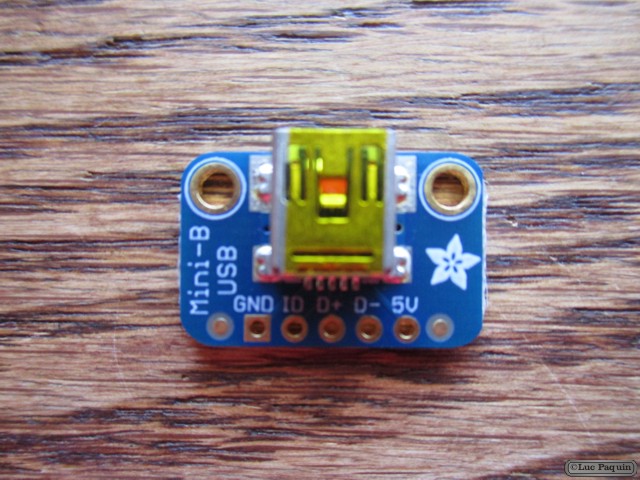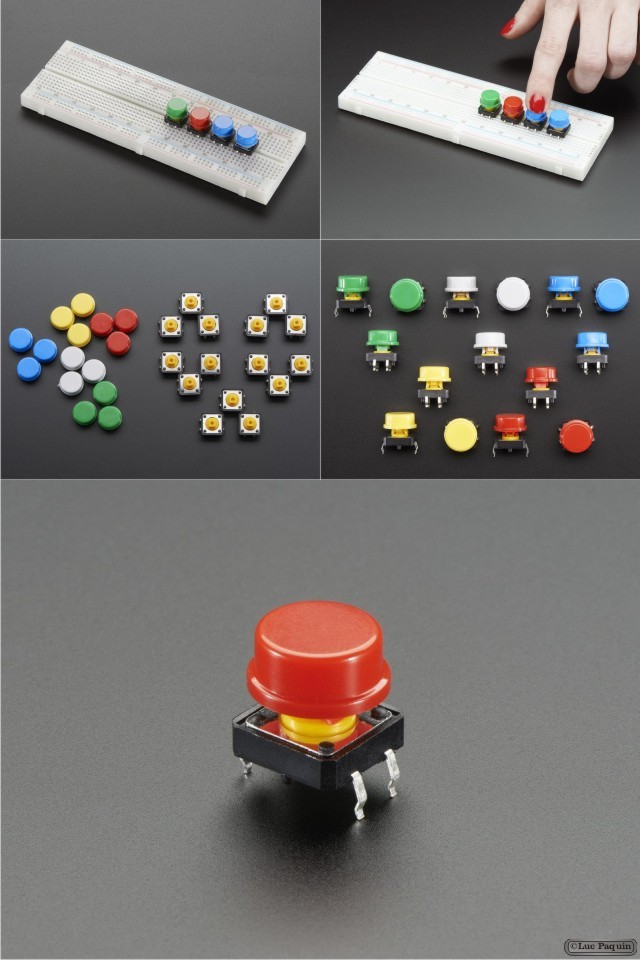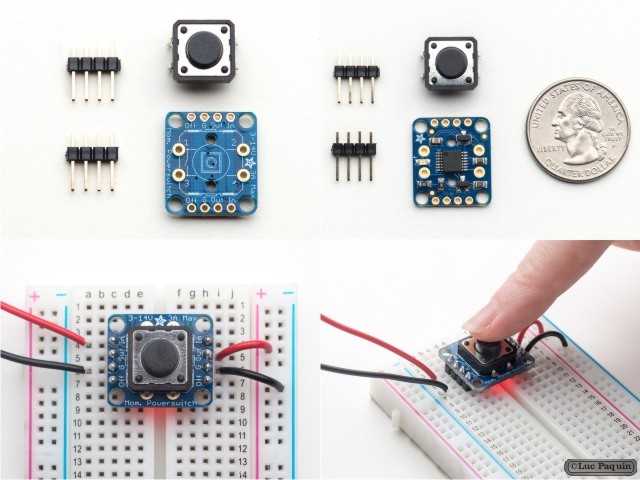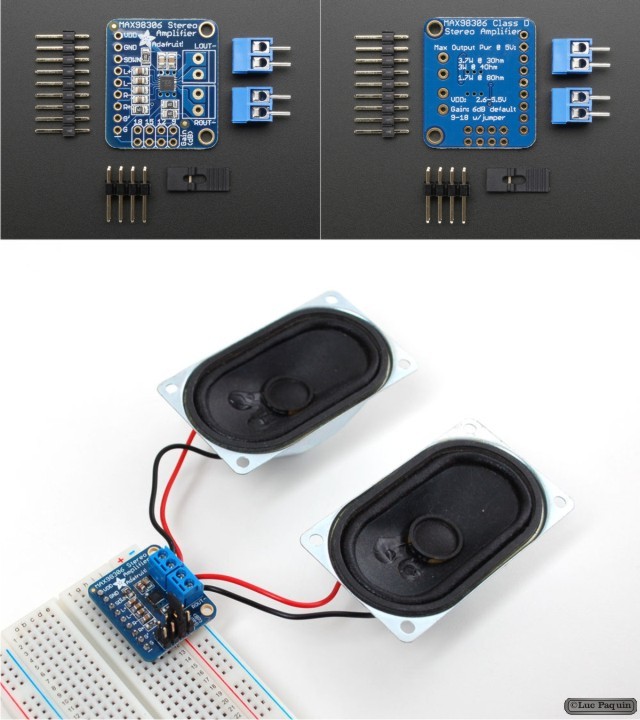Adafruit
Adafruit
Adafruit – 4-pin JST SM Plug + Receptacle Cable Set
Adafruit: 578
Description
These 4-wire cables are 15cm long and come as a set, one side has a JST SM type connector plug on the end. The other side has a matching JST SM type receptacle connector. They are good for whenever you have 4 wires you want to be able to plug and unplug. We like the solid and compact nature of these connectors and the latch that keeps the cable from coming apart easily. For more information, check the JST SM connector datasheet
Our digital addressable LED strip and 12mm pixels also come with JST SM connectors and you can use these cables to connect to the input or output port
These cables can be used to connect to either the INPUT or OUTPUT port of our LPD8806 digital addressable LED strip or the INPUT or OUTPUT port of our WS2801 LED Pixels so that you can easily plug it into your Arduino or similar and also connect another strand to the output, or perhaps apply power to the ‘output’ end.
Each order receives one of each connector.
Technical Details
- JST SM plug + recetacle connector: JST SM connector datasheet
- 15 cm long wires
- 4 wires, 22AWG stranded
Don Luc
Adafruit – USB Mini-B Breakout Board
Adafruit: 1764
Description
Simple but effective – this breakout board has a USB Mini-B connector, with all 5 pins broken out. Great for pairing with a microcontroller with USB support, or adding USB 5V power to a project.
Comes with one fully assembled and tested mini B breakout PCB and a small stick of 0.1″ header so you can solder it on and plug into a breadboard.
Technical Details
Dimensions (without 0.1″ header or terminal blocks):
- Length: 21mm/0.8″
- Width: 13mm/0.5″
- Height: 2mm/0.1″
- Weight: 1.6g
Don Luc
Adafruit – USB/DC Lithium Polymer battery charger 5-12V – 3.7/4.2v cells
Adafruit: 280
Description
Charge your single-cell lithium ion/polymer battery any which way you like with this board. Have a USB connection? No problem, just plug into the miniUSB connector. Only have a wall adapter? Any standard 2.1mm DC adapter which puts out 5 to 12VDC will work fine. If both are plugged in, the charger will automatically choose whichever has the highest voltage.
Other nice things about this charger include multiple LEDs for power & charging status, including a charging LED which will blink when the battery is full. If the charger gets too hot from high-speed charging, it will slow down the charge rate automatically. You can easily adjust the charge rate up to 1.2A or down to 100mA.
For use with Adafruit Lipoly/LiIon batteries only! Other batteries may have different voltage, chemistry, polarity or pinout.
- Use USB or DC power – 5 to 12V input
- Charges one single-cell 3.7/4.2v batteries (not for older 3.6/4.1v cells) with constant current/constant voltage
- Three indicator LEDs – green for Power, orange for charging and red for error
- Charging LED will blink when the battery is full
- You don’t have to worry about heat dissipation in the charger, even when plugging in a 12V DC power jack – thermal protection inside will slow down the charge rate to prevent damage
- 2 JST connections so you can keep the battery plugged in and powering your project
Terminal block connections galore (if you don’t like JST connectors) just solder in 3.5mm terminal blocks - Default charge rate is about 500mA, but you can easily change this by soldering in a through-hole resistor on. The chip can do 100-1200 mA charging
- Safety timer will stop charging after about 14 hours
- The chip supports a standard 10K thermistor, which we have stuffed as a standard resistor. You can solder in a thermistor easily
- Lots of information in the datasheet for the MCP73861
- Fully assembled, tested and comes with a free JST cable
Technical Details
Details:
- Dimensions: 40mm x 44mm x 13mm (1.6in x 1.7in x 0.5in)
- Weight: 11.7g ( 0.4oz)
Don Luc
Adafruit – Colorful Round Tactile Button Switch Assortment
Adafruit: 1009
Description
Little clicky switches are standard input “buttons” on electronic projects. These work best in a PCB but can be used on a solderless breadboard as shown in this tutorial. The pins are normally open (disconnected) and when the button is pressed they are momentarily closed.
These buttons are bigger than the 6mm ones we carry, and come in a pack of 15. Each button comes with a candy-colored round cap that snaps on. You get three of each color– blue, grey, yellow, green, and red. The round plastic button tops affix easily to the tactile switch body.
Assembled button dimensions: 12mm x 12mm x 12mm
Don Luc
Adafruit – PowerBoost 500 Shield – Rechargeable 5V Power Shield
Adafruit: 2078
Description
What’s a project if it’s trapped on your desk? Now you can take your Arduino anywhere you wish with the PowerBoost shield! This stackable shield goes onto your Arduino and provides a slim rechargeable power pack, with a built in battery charger as well as DC/DC booster.
Compatible with Arduino Uno, Duemilanove, Mega, Leonardo and Due – basically any Arduino-pinout-shaped Arduino as only the GND and 5V pins are used. You can stack shields on top, or stack the PowerBoost on top. Please note that the powerboost does not pass through the ICSP headers (the battery is in the way) so if your stacking shield uses ICSP for data transfer (like the Ethernet Shield), you’ll need to stack the PowerBoost above it!
The PowerBoost shield can run off of any Lithium Ion or Lithium Polymer battery (3.7/4.2V kind) but we suggest our 1200mAh capacity or 2000mAh capacity batteries, both of which fits very nicely in the empty space of the shield. Plug in the battery and recharge it via the microUSB jack. When you’re ready to go, just unplug the Arduino from USB or the wall adapter and it will automatically switch over to shield power.
The onboard boost converter can provide at least 500mA current, and can peak at 1A. There’s an onboard fuse to protect against higher current draws which could damage the boost converter or battery.
The shield comes as a kit of parts, some light soldering is required to attach the stacking headers and switch! Battery is not included, but you can pick one up in the shop (again, we suggest our 1200mAh battery or 2000mAh battery, but you can use any 500mAh+ size you like) There’s even an optional switch. If you choose to solder it in, it will let you turn the shield and Arduino power on/off.
Technical Details
- Dimensions: 53mm x 69mm x 2mm / 2.1″ x 2.7″ x 0.08″
- Height w/ JST: 8mm / 0.3″
- Weight: 12.5g
Don Luc
Adafruit – FLORA – Arduino-compatible V1.0a
Adafruit: 659
Description
FLORA is Adafruit’s fully-featured wearable electronics platform. It’s a round, sewable, Arduino-compatible microcontroller designed to empower amazing wearables projects.
The FLORA is small (1.75″ diameter, weighing 4.4 grams). The FLORA family also has the best stainless steel threads, sensors, GPS modules and chainable LED NeoPixels, perfect accessories for the FLORA main board.
The FLORA has built-in USB support. Built in USB means you plug it in to program it, it just shows up – all you need is a Micro-B USB cable, no additional purchases are needed! We have a modified version of the Arduino IDE so Mac & Windows users can get started fast – or with the new 1.6.4+ Arduino IDE, it takes only a few seconds to add Flora-support. The FLORA has USB HID support, so it can act like a mouse or keyboard to attach directly to computers.
The FLORA has built-in USB support. Built in USB means you plug it in to program it, it just shows up – all you need is a Micro-B USB cable, no additional purchases are needed! We have a modified version of the Arduino IDE so Mac & Windows users can get started fast – or with the new 1.6.4+ Arduino IDE, it takes only a few seconds to add Flora-support. The FLORA has USB HID support, so it can act like a mouse or keyboard to attach directly to computers.
FLORA has onboard power switch connected to 2A power FET for safe and efficient battery on/off control, so you can power quite a bit without burning out your switch. The FLORA has an onboard 3.3v 250mA regulator with a protection diode and USB fuse so that the microcontroller voltage is consistent and can power common 3.3v modules and sensors.
We spent a lot of time on the power supply because the FLORA power system is specifically designed to allow easy control and power of a large quantity of addressable NeoPixels. Flora can easily drive 50 pixels directly from the onboard power supply, or up to 500 with the pixels externally powered by a separate 5V supply.
- FLORA is fabric friendly– all the components on board are flush to the PCB and won’t snag delicate garments (it does not use FTDI headers).
- FLORA is extremely beginner-friendly – it is difficult to destroy the FLORA by connecting a battery backwards due to polarized connector and protection diodes. The on-board regulator means that even connecting a 9V battery will not result in damage or tears.
- The FLORA has 4 indicator LEDs: power good, digital signal LED for bootloader feedback, data rx/tx. Also onboard is an ICSP connector for easy reprograming for advanced users. Flora v2 even has an RGB NeoPixel for even more colorful lighting.
- There are 14 sewing tap pads for attachment and electrical connections. Data buses are interleaved with power and ground pads for easy module and sensor attachments without worrying about overlapping traces which are not possible with conductive thread.
- The FLORA works great with the Arduino IDE and is super easy to install support if you have IDE 1.6.4 or later
The FLORA is not the first wearable Arduino / Arduino-compatible. Leah Buechley’s Lilypad was developed in 2007 and while they are both round, FLORA is a completely new platform that works seamlessly with the FLORA accessories.
The FLORA is made in NYC at Adafruit, it was designed by Limor Fried (Ladyada), Adafruit’s founder and engineer. Adafruit has a proven track record of providing 100+ high-quality libraries for Arduino/Arduino IDE, hundreds of tutorials, open-source code and contributions to the Arduino project. Ladyada was a member of the MIT wearables group and likes to sew.
You may get an off-white or black JST connector.
Technical Details
- Dimensions: 45mm round x 7mm thick/ 1.8″ round x 0.3″ thick
- Weight: 4.7g
Don Luc
Adafruit – Micro Lipo – USB LiIon/LiPoly Charger
Adafruit: 1304
Description
Oh so adorable, this is the tiniest little lipo charger, so handy you can keep it any project box! Its also easy to use. Simply plug in the gold plated contacts into any USB port and a 3.7V/4.2V lithium polymer or lithium ion rechargeable battery into the JST plug on the other end. There are two LEDs – one red and one green. While charging, the red LED is lit. When the battery is fully charged and ready for use, the green LED turns on. Seriously, it could not get more easy.
Charging is performed in three stages: first a preconditioning charge, then a constant-current fast charge and finally a constant-voltage trickle charge to keep the battery topped-up. The charge current is 100mA by default, so it will work with any size battery and USB port. If you want you can easily change it over to 500mA mode by soldering closed the jumper on the back, for when you’ll only be charging batteries with 500mAh size or larger.
For use with Adafruit LiPoly/LiIon batteries only! Other batteries may have different voltage, chemistry, polarity or pinout.
- Comes assembled and tested with a free bonus JST cable!
- 5V input via PCB-style USB connector
- For charging single Lithium Ion/Lithium Polymer 3.7/4.2v batteries (not for older 3.6/4.1v cells)
- 100mA charge current, adjustable to 500mA by soldering a jumper closed
- Free 2-pin JST cable included!
Don Luc
Adafruit – Push-button Power Switch Breakout
Adafruit: 1400
Description
The Adafruit Push-button Power Switch is a tidy little design that lets you control a DC power source using an everyday tactile button. The breakout uses a latching analog circuit that is triggered by a push of the button. Press once to turn on, then press again to turn off. The circuit uses a 3A P-FET to connect and disconnect the IN pin to the OUT pin. Works great from 3V to 14VDC and up to 3A (although the FET gets a little toasty at continuous 3A draw) yet has only 0.5uA quiescent current draw.
Using it is easy: connect the power source to Ground and IN, then the load from Ground to OUT. We include a 12mm tactile switch that works well but you can solder in your own switch as well. Press the button (or short the button pins) to alternate between on or off. A on-board red LED will light up when active so you know its working. There’s a fourth KILL pin, which you can use to turn off the load and/or keep it off even if the button is pressed. When 1 or more volts is applied it will instantly turn off the FET. This allows your project to turn itself off.
Comes with a assembled & tested bread-board friendly breakout board with four mounting holes, a 12mm tactile button, and some 0.1″ male header you can solder to the board to plug it into a breadboard.
The power switch is an elegant way to control power to your project, but there are some things to keep in mind: since there is a pass FET, this is only for 3-14V DC voltages. This is not a mechanical switch so there is no air-gap isolation. There is a ‘body diode’ in the pass FET so if the load has a voltage on it that is higher than the input voltage, current will flow back to the input. There is built-in debouncing but very bouncy switches can be annoying as they will turn on and off fast instead of latching.
Technical Details
- Dimensions: 20.51mm / 0.8″ x 17.75mm / 0.69″ x 2.66mm / 0.1″
- Height with Switch: 8.69mm / 0.34″
- Weight: 2.6g
- MC14093 Datasheet (the NAND gate used) P-Channel Pass MOSFET
Don Luc
Adafruit – Stereo 3.7W Class D Audio Amplifier – MAX98306
Adafruit: 987
Description
This incredibly small stereo amplifier is surprisingly powerful – able to deliver 2 x 3.7W channels into 3 ohm impedance speakers. Inside the miniature chip is a class D controller, able to run from 2.7V-5.5VDC. Since the amp is a class D, its incredibly efficient (over 90% efficient when driving an speaker at over a Watt) – making it perfect for portable and battery-powered projects. It has built in thermal and over-current protection but we could barely tell it got hot. This board is a welcome upgrade to basic “LM386” amps!
The inputs of the amplifier go through 1.0uF capacitors, so they are fully ‘differential’ – if you don’t have differential outputs, simply tie the R- and L- to ground. The outputs are “Bridge Tied” – that means they connect directly to the outputs, no connection to ground. The output is a 360KHz square wave PWM that is then ‘averaged out’ by the speaker coil – the high frequencies are not heard. All the above means that you can’t connect the output into another amplifier, it should drive the speakers directly.
Comes with a fully assembled and tested breakout board with 1.0uF input capacitors. We also include header to plug it into a breadboard, 3.5mm screw-terminal blocks so you can easily attach/detach your speakers, and a 2×4 header + jumper to change the amplifier gain on the fly. You will be ready to rock in 15 minutes!
- Output Power: 3.7W at 3O, 10% THD, 1.7W at 8O, 10% THD, with 5V Supply
- Passes EMI limit unfiltered with up to 12 inches (30 cm) of speaker cable
- High 83dB PSRR at 217Hz
- Spread-Spectrum Modulation and Active Emissions Limiting
- Five pin-selectable gains: 6dB, 9dB, 12dB, 15dB and 18dB. Select with a jumper or by setting the G and G’ breakout pins
- Excellent click-and-pop suppression
- Thermal and short-circuit/over-current protection
- Low current draw: 2mA quiescent and 10uA in shutdown mode
Technical Details
Dimensions (without 0.1″ header):
- Length: 28.25mm/1.11in
- Width: 24.15mm/0.95in
- Height: 3.03mm/0.12in
- Weight: 2.33g
Don Luc
Adafruit – Breadboard-Friendly RGB Smart NeoPixel
Adafruit: 1312
Description
This is the easiest way possible to add small, bright RGB pixels to your project. We took the same technology from our Flora NeoPixels and made them breadboard friendly, with two rows of 3 x 0.1″ spaced header on each side for easy soldering, chaining and breadboarding. These ultra-bright LEDs have a constant-current driver cooked right into the LED package! The pixels are chainable – so you only need 1 pin/wire to control as many LEDs as you like.
These pixels have full 24-bit color ability with PWM taken care of by the controller chip. Since the LED is so bright, you need less current/power to get the effects you want. The driver is constant current so its OK if your battery power changes or fluctuates a little.
Each pixel draws as much as 60mA (all three RGB LEDs on for full brightness white). An Arduino can drive up to 500 pixels at 30 FPS (it will run out of RAM after that). Using ribbon cable you can string these up to 6″ apart (after that, you might get power droops and data corruption)
Each order comes with 4 individually controllable pixels. In the photos above we show the pixels with headers soldered on, but the pixels do not come with any headers.
Technical Details
- Dimensions: 0.4″ x 0.5″ x 0.1″ / 10.2mm x 12.7mm x 2.5mm
- 0.5″ (12.5mm) diameter circle PCB, 0.1″ (2.5mm) total thickness
- 800 KHz speed protocol
- Chainable design
- 5-9VDC power (can run at 3.5V but color will be dimmed), constant current 18.5mA per LED (~55mA max total per pixel)
Don Luc






































